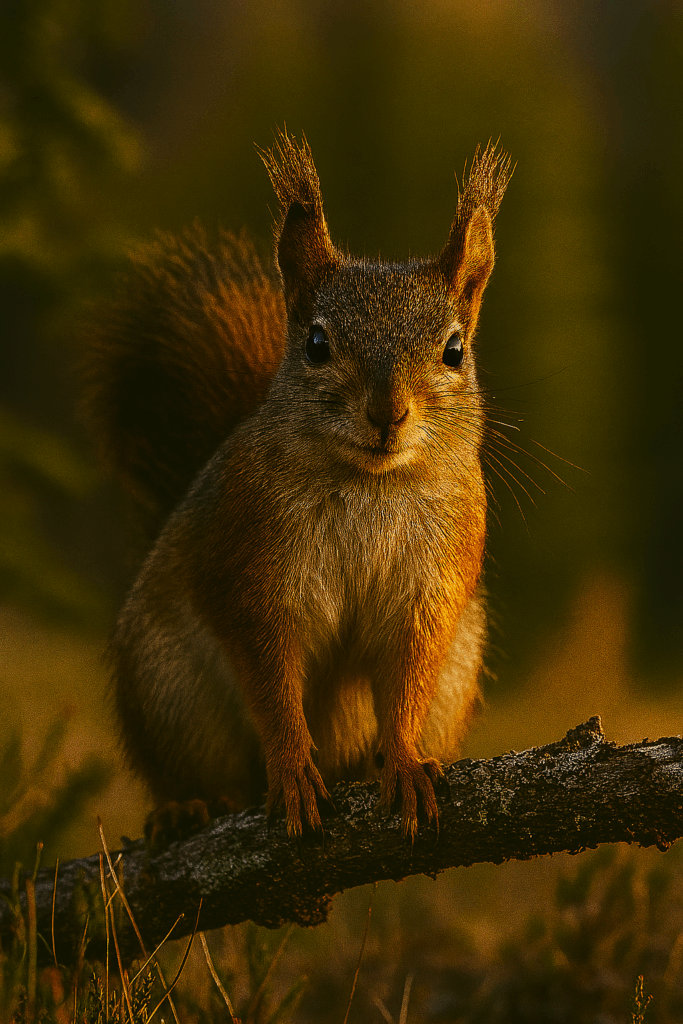Squirrel DIY Hunting Guide & Tips (2025)
Squirrel hunting guide enthusiasts will discover that squirrels are one of North America’s most underrated game animals, offering exciting hunts and great table fare—making this the ultimate squirrel hunting guide for DIY public land success.

Huntable Squirrel Species
Before diving into tactics, know what you’re hunting. North America hosts several huntable squirrel species, each with different habits and regulations. The Eastern gray squirrel (Sciurus carolinensis) dominates forests from the Great Plains eastward, preferring hardwood areas with heavy mast production. Fox squirrels (Sciurus niger) are the largest tree squirrels on the continent, weighing up to three pounds and favoring open woodlands and forest edges. They’re more ground-oriented than grays, spending considerable time foraging on the forest floor.
Red squirrels, also called pine squirrels (Tamiasciurus hudsonicus), are smaller, highly territorial critters found in coniferous forests across Canada, the Northeast, and western mountains. Western gray squirrels (Sciurus griseus) inhabit oak and pine forests along the Pacific Coast but remain shy and less tolerant of human disturbance. Some western states like Colorado also allow hunting of Abert’s squirrels (Sciurus aberti), easily identified by their prominent furry ear tufts and preference for ponderosa pine habitats. Flying squirrels exist but are nocturnal and rarely hunted.
Species Classification
Squirrels belong to the rodent family Sciuridae, which includes over 200 species worldwide. In North America, huntable tree squirrels fall primarily into the genus Sciurus, with red squirrels classified under Tamiasciurus. These animals evolved specialized adaptations for arboreal life, including sharp claws for climbing, powerful hind legs for jumping, and bushy tails that serve as both balance aids and communication tools. Understanding these classifications helps hunters identify legal game and avoid protected species like endangered Carolina northern flying squirrels.
Physical Description
Eastern gray squirrels weigh roughly one pound with gray fur, white undersides, and white-edged tails. Fox squirrels are significantly larger at one to three pounds, displaying orange-brown, rust, or grizzled coloration. Some populations show dramatic color variations from nearly black to blonde phases. Red squirrels are the smallest huntable species, typically under a pound, with reddish-brown coats and white eye rings. Western grays resemble their eastern cousins but are larger with more silver-toned fur and fuller tails. All tree squirrels share characteristic bushy tails, prominent ears, and sharp incisors for gnawing nuts and bark.
Distribution and Habitat
Gray squirrels dominate eastern and midwestern forests, thriving in oak-hickory woodlands and adapting well to urban environments. Fox squirrels prefer edge habitats where forests meet fields, making them common around agricultural areas and scattered woodlots. Red squirrels stick to coniferous forests across northern latitudes, defending territories centered around cone-bearing trees. Western grays occupy Pacific Coast oak and pine forests but avoid developed areas. On public land, focus your efforts on mixed hardwood stands, creek bottoms, and forest-field transitions where multiple species overlap.
Season Dates and Regulations
Squirrel seasons vary dramatically by state and species. Most states open general squirrel seasons in September and run through February, with daily bag limits ranging from four to ten animals. Some jurisdictions offer spring seasons in June targeting breeding adults. Fox squirrel seasons may be more restrictive than gray squirrel regulations, with some states limiting harvest to specific counties or closing seasons earlier. Red squirrel seasons often run longer with higher bag limits due to their territorial nature and stable populations. Always verify current regulations, as some states restrict certain species or close seasons on public lands during specific periods.
Best Hunting Regions
The Midwest and Southeast offer premier squirrel hunting with dense populations and long seasons. States like Kentucky, Virginia, North Carolina, and Arkansas provide excellent fox and gray squirrel opportunities on extensive public forests. The Great Lakes region supports both species plus red squirrels in northern counties. Western states like Oklahoma offer good fox squirrel hunting in eastern counties, while Colorado provides unique opportunities for Abert’s squirrels in ponderosa pine country. Focus on states with abundant public forest land and liberal bag limits for the best DIY hunting experiences.
Hunting Equipment: Gun and Ammo
A .22 Long Rifle rimfire rifle with a 3-9x scope handles most squirrel hunting situations perfectly. Semi-automatic rifles like the Ruger 10/22 allow quick follow-up shots on multiple targets. For shotgun hunters, a 20-gauge with modified choke and No. 5 or 6 shot works well in dense cover where precise rifle shots prove difficult. Air rifles producing 600+ feet per second energy levels provide quiet hunting for suburban areas where discharge ordinances permit. Always carry extra ammunition—squirrel hunting often presents multiple opportunities in short time frames.
Hunting Methods and Techniques
Still-hunting along forest edges during early morning and late afternoon produces consistent results when squirrels feed actively. Set up against large trees in oak flats and wait for feeding sounds—rustling leaves, falling nut shells, or chattering calls. During midday hours when activity slows, search for leaf nests in tree forks and glass openings with binoculars. Fox squirrels often forage on the ground, making them vulnerable to careful stalking through open woodlands. Red squirrels defend middens—cone caches—aggressively, so locate these areas for concentrated hunting opportunities. Cold weather pushes activity into midday warming periods, while windy conditions scatter feeding patterns.
Licenses and Tags
Every state requires a small game license for squirrel hunting, often bundled with resident hunting licenses. Some jurisdictions require additional habitat stamps or conservation fees. Hunter education certification remains mandatory in most states for first-time license holders. A few states sell special squirrel stamps or permits, particularly for premium public hunting areas. Purchase licenses online or at sporting goods stores, but always carry physical copies afield along with required identification.
Diet and Feeding
Squirrels are opportunistic feeders consuming nuts, seeds, fungi, insects, bird eggs, and seasonal fruits. Oak acorns form the backbone of fall and winter diets, with hickory nuts, walnuts, and beechnuts providing additional mast. Red squirrels specialize on conifer seeds, creating large cone caches called middens. Spring diets include tree buds, flowers, and maple sap, while summer brings berries, mushrooms, and garden crops. Locate prime feeding areas by searching for nut shell debris, stripped pinecones, or mushroom remnants. Fresh feeding sign indicates active areas worth hunting repeatedly.
Reproduction and Life Cycle
Most squirrel species breed twice yearly, with peak activity in late winter and midsummer. Females produce litters of three to five young after 44-day gestation periods. Young squirrels emerge from nest cavities or leaf dreys at 10-12 weeks, remaining with mothers through their first winter. Mortality rates reach 75% in the first year due to predation, disease, and accidents. Adult squirrels rarely live beyond five years in the wild. Understanding breeding cycles helps predict population fluctuations and hunting success—good acorn crops typically produce higher survival rates and hunting opportunities the following season.
Population Status
Gray and fox squirrel populations remain stable or increasing across most of their ranges, thanks to effective wildlife management and habitat restoration. Historical harvest records show dramatic declines from early 20th-century levels, but modern populations support sustainable hunting pressure. Red squirrel numbers fluctuate with conifer seed production cycles but remain stable overall. Some subspecies like western gray squirrels face conservation concerns due to habitat loss and fragmentation. Hunters contribute valuable population data through harvest reporting and license sales funding management programs.
Meat Quality and Processing
Squirrel meat offers lean, mild-flavored protein comparable to rabbit when properly prepared. Field dress animals immediately by removing entrails and cooling carcasses quickly. Skin squirrels by making cuts around legs and peeling hide off like a sock—YouTube tutorials make this technique easy to master. Soak cleaned carcasses in saltwater for several hours to remove any residual blood. Quarter large fox squirrels for easier cooking, while smaller grays can be cooked whole. Traditional preparations include frying, stewing, or smoking the meat for jerky.
Safety Considerations
Always positively identify your target before shooting—never shoot at sounds or movement alone. Wear hunter orange where required and maintain muzzle control when moving through cover. Be aware of other hunters in popular public areas and establish clear shooting lanes to avoid accidents. Carry a first aid kit and inform someone of your hunting location and expected return time. Watch for hazardous conditions like wet leaves on steep slopes or dead branches overhead. High-velocity .22 bullets can travel over a mile, so ensure adequate backstops before firing.
Tracks and Sign
Squirrel tracks show four toes on front feet and five on rear feet, measuring roughly two inches long. Look for distinctive bounding track patterns where hind feet land ahead of front feet in snow or mud. Fresh feeding sign includes gnawed nut shells, stripped pinecones, and mushroom stems. Nest sites appear as large leaf bundles in tree forks or holes in mature trees. Bark scratches on smooth trees indicate climbing routes to feeding areas. Red squirrels create distinctive cone middens—huge piles of stripped cone scales beneath favorite feeding perches.
Similar Species
Flying squirrels remain nocturnal and rarely encountered during daylight hunting. Ground squirrels like chipmunks and prairie dogs inhabit different ecosystems and display distinctive striped patterns or colonial behaviors. Distinguish fox squirrels from grays by size, color, and behavior—foxes spend more time on the ground and move more deliberately. Regional color variations can confuse identification, but size differences remain consistent. When in doubt, consult local wildlife agency identification guides or experienced hunters familiar with regional populations.
Squirrel hunting teaches woodsmanship, marksmanship, and patience while providing excellent table fare and year-round opportunities. Master these fundamentals on public land and you’ll never need an outfitter to fill your game bag with these abundant, delicious game animals.
